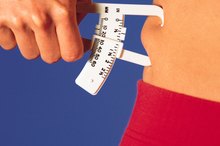Neck vs. Waist Body Fat
Your body is made of fat mass and lean mass. Fat can be subcutaneous, sitting directly under the skin, or visceral, stored deep in the abdominal cavity. Lean body mass includes everything else in your body like bones, muscles, organs and water. Your body needs some fat to function properly, but too much fat or fat in the wrong places can cause problems. For example, fat stored in the upper body -- the neck and waist -- is more dangerous than fat stored below the waist. An easy method to estimate neck and waist body fat is to measure body circumference.
Body Fat
Body fat makes up cell membranes and nerve sheaths. It pads vital organs, stores energy and produces hormones. Health club staffers and doctors can measure your body fat with different tools including skin fold calipers, bioelectric impedance, hydrostatic weighing, dual energy X-ray absorptiometry and body circumference measurements. There are also bioelectric impedance tools you can use at home. Your body fat percentage is an estimate of how much fat makes up your total body mass. You can determine the actual pounds of fat in your body with a simple formula. Multiply your percentage of body fat by your weight. If you weigh 150 pounds and have 20 percent body fat, your body contains about 30 pounds of fat. The remaining 120 pounds are lean body mass.
Waist Body Fat
Muscle Mass & BMI
Learn More
Belly fat is made up of both subcutaneous fat and visceral fat. Visceral fat wraps around your body's organs and is a known risk factor for cardiovascular disease, stroke, Type 2 diabetes, cancer and dementia. The only way to determine the exact percentage of visceral fat in your belly is with a CT scan, but because subcutaneous and visceral fat together contribute to a larger waistline, as your waist grows, so does the amount of visceral fat. An easy way to estimate your visceral fat is to measure your waist circumference. Healthy men should strive for a waist measurement of 37 inches or less, while healthy women should try to keep their waistline at 32 inches or less, according to the journal "Clinical Nutrition."
Neck Body Fat
Neck body fat is a measure of upper body fat, which is associated with cardiovascular disease beyond the risks of visceral abdominal fat. Neck fat, which can be estimated by measuring your neck circumference, is associated with unhealthy cholesterol levels, diabetes risk, metabolic syndrome and obstructive sleep apnea syndrome. A study published in the “Journal of Clinical Endocrinology and Metabolism,” showed a stronger relationship between risk factors and neck circumference in women than in men. It also found that individuals with both a larger neck circumference and a larger waistline were the most at risk. Health men should aim for a neck size around 16 inches and healthy women should aim for about 13 inches.
Considerations
The Ideal Body Fat Percentage
Learn More
Each person is unique and no single method exists that can determine your personal ideal body weight and percentage of body fat. Furthermore, the tools that are available for measuring body fat each have their own shortcomings and are not perfectly accurate. Whenever specific numbers are provided to determine health risks, they have been determined after studying many people and coming up with ideal guidelines for healthy individuals. Instead of focusing on just meeting the numbers, focus on maintaining overall health and well-being.
Related Articles
References
- Journal of Clinical Endocrinology and Metabolism: Neck Circumference as a Novel Measure of Cardiometabolic Risk: The Framingham Heart Study
- Clinical Nutrition: Neck Circumference As A Measure of Central Obesity: Associations With Metabolic Syndrome and Obstructive Sleep Apnea Syndrome Beyond Waist Circumference
- Neurology: Central Obesity and Increased Risk of Dementia More Than Three Decades Later
Writer Bio
Cindy Killip is a health and fitness specialist, health coach, author and speaker who has been teaching and writing about exercise and wellness since 1989. She authored "Living the BONES Lifestyle: A Practical Guide to Conquering the Fear of Osteoporosis." Killip holds multiple certifications through the American Council on Exercise and degrees in communications and sociology from Trinity University.









